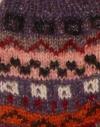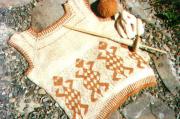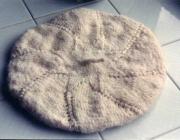Most Common Knitting Pattern Stitches
The most commonly used knitting stitches for patterns are
- Garter Stitch
- Stockinette Stitch
- Seed Stitch and
- Ribbing
Here's how to do these easy knit patterns:
Garter Stitch: This is usually the first knit stitch pattern learned by beginning knitters. This pattern uses only the knit stitch when knitting flat on two needles. It creates a fabric that lays perfectly flat. Perfect for scarves, quick hats, and patterns. The only problem with garter stitch is that it is clunky and thick. It doesn't look good with color changes.
If garter stitch is worked in the round it would be done by knitting one row, purling the next row, then repeat. Garter stitch is almost never done in the round, because what's the point? Usually the only reason to do garter stich is because a new knitter doesn't know how to purl!

Stockinette Stitch: This is the basic stitch you see on plain sweaters and socks. It's distinguishing feature is the flat smooth texture on one side (the knit side) and the bumpy textured back (the purl side).
Stockinette stitch is the knitting stitch always used for two-color patterns, because the flat knit side is nice and smooth making a perfect pallet to display color patterns.
Stockinette stitch creates a fabric that is thinner than any other stitch except an open lace pattern. A fabric made with stockinette stitch is pliable and soft, with a distinct front and back.
The problem with stockinette stitch is that it curls unless sewn together or edged with another stitch such as ribbing.
Here's how to do the Stockinett Stitch Pattern:
Knit 1 row, purl 1 row, alternately when working on straight needles. When working round and round on a circular needle or double pointed needles, knit every round.
Seed Stitch: This is a wonderful stitch because it creates a fabric that lays perfectly flat, and yet has a more open texture than garter stitch. It is very pretty with the alternating purl backs looking a bit like seeds. With a shiny yarn the seeds can catch the light with an attractive glitter.
How to do Seed Stitch Pattern:
On the first row * K1, P1, repeat from * to end of row. On all subsequent rows, K over the P st and P over the K st.
Ribbing: This is an often used stitch that makes nice edgings because ribbing both lays flat and draws a fabric inwards; creating an elastic effect.Used for collars, cuffs, bands, and hems.
Ribbing pattern can be of many different thicknesses from a tight k1, p1, ribbing to even 4 stitches on each rib.
How to do Ribbing Pattern:
On the fist row work in the ribbing pattern. On all other rows K over the K sts and P over the P sts.
- Spincraft Patterns's blog
- Log in or register to post comments



